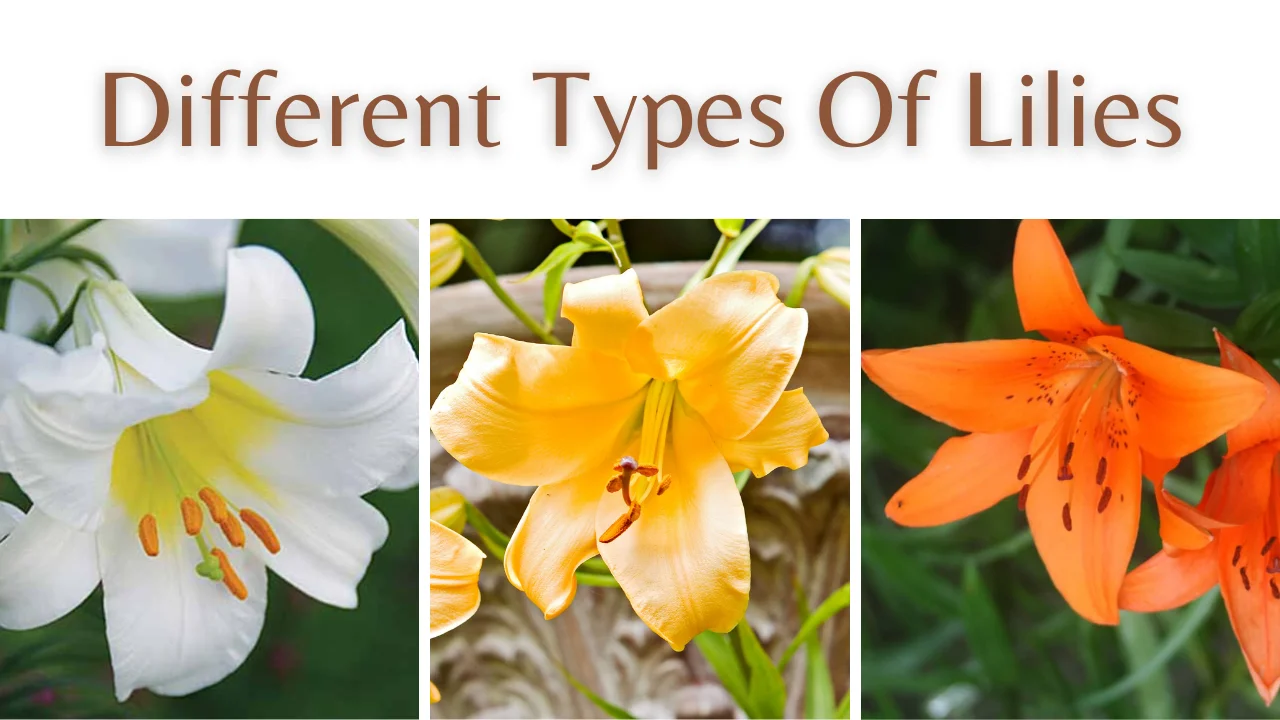Different Types of Lilies encompass a captivating spectrum of colors, sizes, and shapes, adding unparalleled grace and elegance to gardens, bouquets, and floral arrangements worldwide.
These enchanting flowering plants, belonging to the Lilium genus, are celebrated for their diverse characteristics and unique charm.
The royal Asiatic lilies, renowned for their vivid red, orange, and yellow colors, and the fragrant and elegant Oriental lilies, known for their bigger, spectacular blooms and enticing perfume, provide a great selection for every taste and gardening style.
Trumpet lilies’ trumpet-shaped flowers and Tiger lilies’ stunning markings add to the Lily family’s variety. In exploring different types of lilies, we will venture into the enchanting world of these perennial favorites, delving into their distinct features, care requirements, and the timeless allure they bring to floral design and garden landscapes.
Top 10 Different Types of Lilies
Explore a list of ten different types of lily species. Learn about the variety of lilies and their unique characteristics.
1: The Leopard Lily, or Lilium Pardilinum
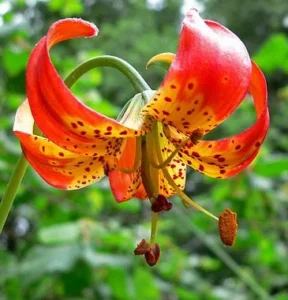
Source Pinterest
- Height 5-6ft
- Blooms in mid-summer
The Lily of the Leopard is an indigenous plant on the California-Oregon coast in North America. The tall stalks have colorful blossoms that dangle down like miniature lanterns.
The outside edges of the petals are brilliant orange-red, while the inner core is a sunny yellow. This lovely lily gets its popular name from the smattering of darker specks on the yellow regions.
One of the rare species of lily that can survive in conditions of partial shade is the L. pardalinum, which is native to forests. When given a few years, the tall flower spikes may reach six feet, and the plants will cluster together naturally.
2: Lilium Canadense (Canada Lily)
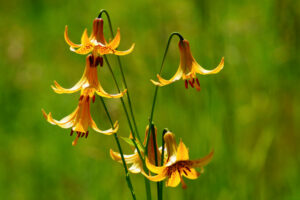
Source Pinterest
- 4-6 m in height
- Blooms in June and July
This plant is native to North America and goes by many common names. Over the last 400 years, L. canadense has thrived under human care, making it a true veteran of the plant world.
Only a few lily species, including L. canadense, exhibit the rare stoloniferous bulb structure. It implies that the shoots emerge from the bulb’s base rather than the top and expand outward for a few inches. New bulbs develop at the tips of these shoots, and development proceeds upward.
canadense is more refined and delicate than its big-trumpet relatives. The centers of the dangling yellow flowers are faintly freckled with orange-brown dots, and the pointed points sweep out and upwards.
3: Lilium Lancifolium or Tiger Lily
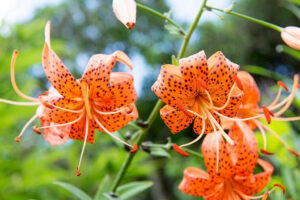
Source Pinterest
- 4 to 5 feet in height
- Flowers in the early part of summer
The traditional white Madonna Lily is one of the oldest lily species. Her pure, white flowers have been used for aesthetic and culinary purposes since before the Christian era.
Give your Madonna lily a sunny spot in well-drained soil; she won’t ask for much in return. This lily is picky about soil PH; adding some lime won’t hurt its ability to thrive.
The blooms feature huge, broad, white petals occasionally tinged with a faint green in the middle. The anthers shine with a bright golden hue.
Madonna lily bulbs should be planted lower in the ground than you would ordinarily. It would be best to keep them safe from other lilies since they are susceptible to contracting viruses from other plants.
4: Lilium Candidum
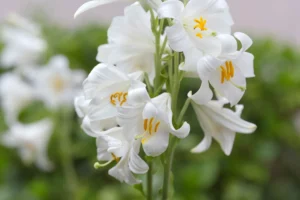
Source Pinterest
- Size: 2–4 meters
- Flowering time is early summer
The traditional white Madonna Lily is one of the oldest lily species. Her pure, white flowers have been used for aesthetic and culinary purposes since before the Christian era.
Give your Madonna lily a sunny spot in well-drained soil; she won’t ask for much in return. This lily is picky about soil PH; adding some lime won’t hurt its ability to thrive.
The blooms feature huge, broad, white petals occasionally tinged with a faint green in the middle. The anthers shine with a bright golden hue.
Madonna lily bulbs should be planted lower in the ground than you would ordinarily. It would be best to keep them safe from other lilies since they are susceptible to contracting plant-infecting viruses that originate from other plants.
5: Lilium ‘Connecticut King’
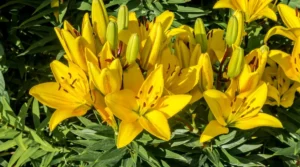
Source Pinterest
- Height 2-3ft
- Blooms in June
Lilium ‘Connecticut King’ is a popular flower in the cut-flower market known for its big, flawless, golden blooms. Its green leaves are vibrant and eye-catching. This flower is a favorite for bouquets and arrangements, adding a touch of luxury.
With its stunning blossoms and lively green leaves, ‘Connecticut King’ stands out in gardens and floral displays. It is a top choice for florists and garden lovers looking to create beautiful arrangements or enhance their outdoor spaces.
6: Lilium Speciosum
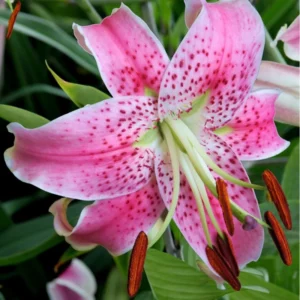
Source Pinterest
- Height 4-5ft
- Blooms in early autumn
Japan is the country where L. speciosum first appeared in nature. If you want your lilies to bloom longer than usual, this is an excellent option because it is one of the few kinds of flowers later in the season. Flowers often start to emerge in the early fall.
Flowers hang down from the thin stalks, which might be white or pale pink. Each flower has deeper pink dots and elevated ‘papillae’ markings.
If you have alkaline soils, you must cultivate your L. speciosum lilies in pots filled with ericaceous compost since this species hates lime.
7: Lilium Henryi (Henry’s Lily)
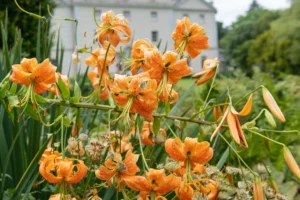
Source Pinterest
- 4–8 meters in height
- Blooms between the beginning and middle of summer
Dozens of stunning tropical orange blossoms may be harvested from the Henry’s Lily plant. Each has a lovely feel because of the pattern of raised red bumps covering its surface.
The robust stems grow at an angle, and the petals are twisted in a classic Turk’s Cap fashion to point backwards as if reaching out to touch the stalks. Plantings in an informal or natural style work very well with Henry’s Lily.
Many well-known hybrids owe a debt of gratitude to L. Henryi. It is hardy and long-lived, but its greatest strength is that it does not care what kind of soil it is planted in.
As a result of L. Henryi passing on its DNA, well-known trumpet and oriental hybrids are now capable of growing well in alkaline soils.
8: Lilium Aura Tum

Source Pinterest
- Height 3-4ft
- Blooms in late summer
This wild Japanese lily is remarkable for its large, open flowers, which may measure up to 12 inches in diameter. Plant them close to the home, so you may enjoy their wonderful scent daily and keep them from moving too far away!
The white petals are adorned with yellow stripes in the middle, making them seem like stars. The petals of most types include a smattering of tiny black dots, whereas the petals of others are a more uniform shade of pink.
Aura tum, like its close cousin L. speciosum, dislikes lime and does better in neutral than acidic soil when grown in a garden border. It could survive rather well while restricted. Ericaceous manure combined with grit for outflow would be an excellent choice to fulfil the task’s requirements.
9: Lilium Longiflorum
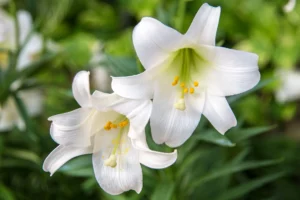
Source Pinterest
- 2–4 meters in height
- Blooms in the late summer months outside
The exquisite Easter lily is known for its trumpet-shaped, pure white flowers, and it is possible that several super hybrids, such as ‘White American’ and ‘White Heaven,’ can trace their ancestry back to this species.
Those fortunate enough to reside in warmer regions may successfully cultivate this stunning lily in open-air settings. Easter lilies can only be grown successfully in warmer regions, either under glass or in containers that may be brought inside for the winter.
10: Lilium Bulbiferum
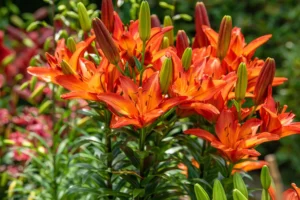
Source Pinterest
- Height 3-4ft
- Blooms in early summer
The hilly regions of Southern Europe are where the first confirmed observations of this species, also known as the Fire Lily, were made. “Fire Lily” is occasionally used to describe this particular species. Many desirable Asiatic hybrids may trace their ancestry back to L. bulbiferum.
Although it barely grows 30 inches tall, the Fire Lily’s flowers are magnificent. In early summer, seek out wide, open bowls of blossoms with a rich tangerine orange hue. Spots of a deeper, Chocolatey hue adorn the petals.
Bulbils, or miniature bulbs, grow in abundance in this plant’s axil (the space between the leaf and stem), making it very simple to spread. When they separate easily, pluck them off and put the plant in a container.

